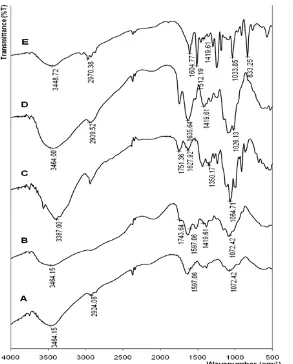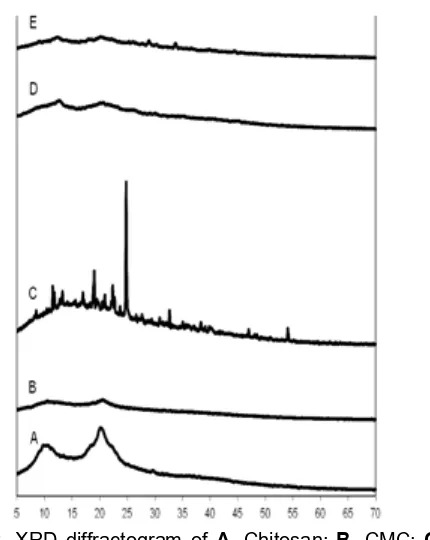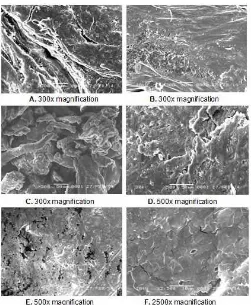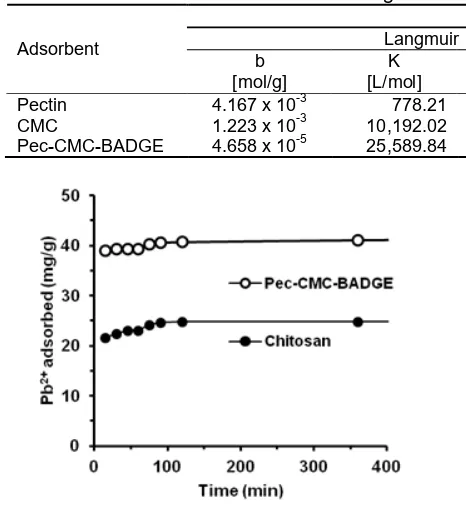PREPARATION AND Pb(II) ADSORPTION PROPERTIES OF CROSSLINKED
PECTIN-CARBOXYMETHYL CHITOSAN FILM
Budi Hastuti
1,2,*, Mudasir
2, Dwi Siswanta
2, and Triyono
2 1Department of Chemistry Education, Faculty of Faculty of Teacher Training and Education, Universitas Sebelas Maret Jl. Ir. Sutami 36A Surakarta 57126, Indonesia
2
Department of Chemistry, Faculty of Mathematics and Natural Sciences, Universitas Gadjah Mada Sekip Utara PO BOX BLS 21 Yogyakarta 55281, Indonesia
Received February 11, 2015; Accepted June 30, 2015
ABSTRACT
A modified pectin has been synthesized by reacting/combining -OH group among pectin and chitosan with BADGE (Bisphenol A diglycidyl ether) crosslinker agent. The structure and morphology of the new material were characterized by Fourier transform infrared (FTIR) spectroscopy, scanning electron microscopy (SEM) and X-ray Diffraction (XRD) analysis. Thermogravimetric studies showed an improvement in thermal characteristic. Adsorption experiments were performed in batch processes; sorption isotherms and kinetics were also studied. The Langmuir and Freundlich adsorption isotherm models were applied to describe the isotherms and isotherm constants for the adsorption of Pb(II) ion onto adsorbent pectin-carboxymethyl chitosan-BADGE (pec-CMC-BADGE). The dynamic study showed that the sorption process followed the second-order kinetic equation. Result indicated also that Pb(II)
ion uptake could be well described by the Langmuir adsorption model of pec-CMC-BADGE and CMC with G° of
25.3 and 23.1 kJ mol-1, respectively, while that of pectin followed Freundlich isotherm model.
Keywords:pectin; carboxymethyl chitosan; BADGE; adsorption; Pb(II)
ABSTRAK
Pektin termodifikasi disintesis melalui penggabungan gugus fungsi –OH dari pektin dan kitosan dengan agen penaut silang Bis fenol A diglisidil eter (BADGE). Sruktur dan morfologi dari material baru tersebut dikarakterisasi menggunakan spektrofotometer FTIR, mikroskop elektron (SEM) dan difraksi sinar X (XRD). Studi Termogravimetri dikembangkan untuk menunjukkan karakter termal. Eksperimen isoterm adsorpsi dan kinetik dilakukan melalui proses Batch. Model isoterm adsorpsi Langmuir dan Freundlich dilakukan untuk menentukan besarnya konstanta isoterm adsorpsi dalam penyerapan ion Pb(II) oleh adsorben Pektin-Karboksimetil kitosan-BADGE (pec-CMC-BADGE). Studi dinamika menunjukkan bahwa proses penyerapan dari adsorbent tersebut mengikuti persamaan kinetik pseudo orde dua. Hasil penelitian menunjukkan bahwa ion Pb(II) dapat diserap oleh adsorben
pec-CMC-BADGE dan CMC melalui model adsorpsi Langmuir dengan G° masing-masing 25,3 dan
23,1 kJ mol-1, sedangkan pektin melalui model isoterm adsorpsi Freundlich.
Kata Kunci:pektin; karboksimetil kitosan; BADGE; adsorpsi; Pb(II)
INTRODUCTION
Waters contamination by industrial wastes, particularly heavy metals such as Cu, Ni, Zn, Cr, Hg, Cd, Pb, is one important issue recently. Those hazardous and unbiodegradable materials are known to produce adverse effects to the environment and public health. A number of methods have been developed for heavy metals removal from industrial wastes, such as deposition (chemical precipitation), ion exchange, coagulation, mechanical filtration, membrane separation, electro deposition, complexation, and solvent extraction [1-2]. However, those currently available methods have
some practical limitations, such as limited tolerance to the pH change, less selective to the metal, and high-cost [3]. Thus, a simple technology for treatment of heavy metals contamination is preferred as an alternative method. Adsorption-based methods have been extensively studied as it is easy, simple, effective, non-toxic and biodegradable. It is basically based on the interaction between metals and functional groups of the adsorbent, such as -OH, -NH, -SH and -COOH, which exist on its surface through complex formation [4].
widely found in plant cell walls. The carboxylic groups of pectin can be applied to bind heavy metals by forming complex compounds that are insoluble in water. Moreover, modification of pectin can be done by cross-linking technique with certain cross-linker agent. However, a variety of cross-linker reagents, such as isocyanates, epoxides, amines, acid anhydride, etc. are mostly soluble in organic solvents, while pectin is soluble in water. In addition, many of these reagents are sensitive to moisture and water-insoluble. Therefore, a suitable cross-linker for pectin is limited. CaCl2, ethylene
glycol diglycidyl ether (EGDE) and poly ethylene glycol diglycidyl ether (PEGDE) are an example of few cross-linker that are soluble and stable in water. Modification of pectin with glutaraldehyde, CaCl2, and EGDE can
produce a water-adsorbing super adsorbent hydrogel [5]. Chitosan, mainly derived from crustacean shells, is another biomaterial that can be used as heavy metal adsorbent. It has amine (-NH2) and hydroxyl (-OH)
functional groups, which is highly reactive and alkaline. However, chitosan is easily soluble in acetic acid and also partially soluble in dilute acid, such as HNO3, HCl,
HClO4, and others. In an acidic condition, a number of
amine groups which is an active group capable to bind a metal ion will be reduced. Thus, the direct use of chitosan as an adsorbent is less effective. Modification of active groups on chitosan is thus subjected to improve its stability and durability towards acid condition. This modification is done by cross-linking active groups of chitosan with cross-linker agents, such as glutaraldehyde [6], epichlorohydrin [7], chloromethyl oxirane, polyethylene glycol (PEG), ethylene diamine diglycidyl ether (EDGE), etc. A cross-linked chitosan has a better stability, as it is insoluble in water, but unstable under more extreme conditions, such as under strong acids or bases [8].
Modification of chitosan can also be performed by grafting another groups to the active -NH2or -OH groups
of chitosan with, for example, acetate, succinyl or maleic groups. Some studies have modified chitosan by grafting the active group with the addition of substituent carboxymethyl chitosan, 2-carboxyethyl, carboxybutyl and acyl maleate on the hydroxy and amine of chitosan [9-10]. Grafting on chitosan can also be done by adding succinic anhydride [11]. The ability of chitosan as an adsorbent will be increased by grafting amine group with chloroacetic groups to form carboxymethyl chitosan (CMC).
In this study, modification of pectin and carboxymethyl chitosan (CMC) was performed with BADGE (bisphenol A diglycidyl ether) through reflux method, where BADGE was used as the cross-linker agent. This approach is done with the assumption that the active groups available in both pectin and chitosan are not consumed during the course of cross-linking
process. Thus, it is expected that the active groups of adsorbent can be utilized optimally to absorb metal ions. Cross-linking between pectin and chitosan polymers is aimed to improve the stability of adsorbent, particularly under low pH, as well as to increase the adsorption capacity of the adsorbent.
The modified adsorbent is called pectin-CMC-BADGE film, where -COOH group will strongly bind metal at the position of H+ (-COOH) that will be replaced by metal ions. Cross-linking of pectin-CMC in the film is expected to make the adsorbent structure being more pre-organized and more stable on chelating reaction with metal ions. It has been reported that cross-linking of -OH group on chitosan using epichlorhidrin increase the stability of chitosan and its adsorption capacity towards metal ions [1]. Thus, it is expected in this study that pectin-CMC-BADGE film would be a promising adsorbent for uptaking the metal ions, in this case Pb(II), from water solution. Furthermore, this material can be used for treatment of heavy metal contamination in aquatic environment.
EXPERIMENTAL SECTION
Materials
Chitosan with the deacetylation degree in the range of 75-85% and BADGE were purchased from Sigma Aldrich (Germany). chloroacetic acid, aceton, HCl 37%, HNO3, Pb(NO3)2 were purchased from E.
Merck (Germany).
Instrumentation
The instruments used for adsorbent characterization were included Fourier Transform Infrared (FTIR) spectrometer (Shimadzu Prestige-21) for identifying the presence of functional groups and Scanning Electron Microscope (SEM, JSM-6360 LA) for characterizing the structural morphology. A
Shimadzu X-ray diffractometer (XRD) with Cu K-α
radiation was used for evaluating the crystalline level of the films and Differential Thermal Analysis and Thermogravimetric Analysis (DTA-TGA) (Perkin-Elmer DTA-TGA) for evaluating thermal stability. Atomic absorption spectrophotometry (AAS) (Perkin Elmer 3110) for measuring the concentration of Pb in solution.
Procedure
Preparation of adsorbent
isopropanol. The reaction mixture was stirred at room temperature for 12 h. The mixture was filtered and washed with ethanol and then dried in oven to obtain CMC. The next step, 0.2 g pectin and 0.2 g CMC were dispersed in 10 mL acetic acid 5% respectively and then 0.113 g of BADGE in 25 mL acetone was added and stirred for 2 h. The mixture was poured in a petri dish and dried in oven. The membrane was than immersed in an aqueous solution of sodium hydroxide (1 mol/L) for 12 h, and then washed with distilled water.
Characterization
The membrane was analyzed with FTIR spectrophotometer using KBr pellet method on wave number of 400-4000 cm-1. TG-DTA was recorded in the range temperature of 30-600 °C in air atmosphere with increasing temperature rates of 10 °C/sec. XRD analysis
was done with powder method at 2θ from 5-60 °C.
Adsorption experiment
Adsorption properties of chitosan, pectin, and pec-CMC-BADGE for Pb(II) ion were studied by a batch technique. A series of 10 mL of 50 ppm Pb(II) solutions, which their acidities were adjusted to pH 2.0 to 6.0 by adding HNO3 or NaOH, were placed in a
bottles containing 10 mg of adsorbent and shaked for 12 h at 90 rpm. The mixture was filtered with Whatman filter paper No. 42, and the concentration of Pb(II) in filtrate was then analyzed by using AAS. Variation of contact times (0 to 2160 min) was used for determination of adsorption kinetics. Similar procedure was carried out by varying the concentration of Pb(II) (0 to 500 mg/L) for the determination of adsorption isotherm.
RESULT AND DISCUSSION
Infrared (IR) spectrum of chitosan (Fig. 1A) shows absorption peaks at 3425 cm-1which correspond to O-H
and N-H stretching vibration, at 1636 cm-1 which correspond to -NH2, and characteristic absorption band
at around 2931 cm-1 due to C-H stretching vibration of methylene. The broadening and shift of -OH peak is probably caused by the overlap with that of -NH of the amine. Absorption band at 2878 cm-1 is a stretching vibration of C-H group methylene and at 1026 cm-1 is belongs to C-O group. Another band of chitosan is observed at 1651 cm-1, indicating the presence of amide groups (-NHCO) [12-13].
IR spectrum of CMC (Fig. 1B) shows absorption peak at wavenumber of 3464 cm-1 belongs to the absorption of the -OH stretching vibration that overlap with that of -NH stretching vibration. Peak absorption of C-H stretching vibration shifted from 2931 to 2924 cm-1. Increasing the absorption peak of carbonyl bands (stretching C=O) at 1640 cm-1indicates the addition of a carboxylic group (-COOH), suggesting that CMC has been successfully formed from the reaction between chitosan and chloroacetic acid [12-13].
IR spectrum of pectin (Fig. 1C) shows a broad absorption band at 3387 cm-1, indicating the presence of the OH group vibrations. Peak at 1064 cm-1 is the stretching vibration of -CO. Absorption at 1628 cm-1is a specific absorption for -COOH group [14-16].
Furthermore, IR spectrum of pectin-CMC-BADGE (Fig. 1D) shows that this material has hydroxide (-OH) active groups, which is indicated by the presence of peak at wave numbers of 3425 cm-1 and an active carboxylic group (-COOH) at 1604 cm-1. The bands related to C=O stretching of the ester could be observed also at 1743 cm-1[17-19]. Peak on 833 cm-1corresponds to para-substituted C-H on benzene ring. This indicates that BADGE has been cross-linked between pectin and chitosan.
Physical Properties of Adsorbent
XRD pattern of CMC adsorbent (Fig. 2) shows
peaks at an angle (2Ɵ) of 10° and 20° degrees [20],
whereas pectin shows one broad sharp peak only at an
angle (2Ɵ) = 25° degree. Pec-CMC-BADGE adsorbent
shows no peak in the XRD pattern. This fact probably indicates that its ability of forming hydrogen bond has been decreased after chemical modification and therefore pec-CMC-BADGE adsorbent becomes amorphous material. It shows that pec-CMC-BADGE adsorbent is more stable.
DTA-TGA Analysis
Thermogram of DTA-TGA of chitosan (Fig. 3A) shows thermal degradation at two stages. The first stage was at temperature 110-240 °C with weight loss of 20%, due to the decomposition of polymer. It was followed by
Fig 2. XRD diffractogram of A. Chitosan; B. CMC; C. Pectin;D.Pectin-CMC;E.Pectin-CMC-BADGE
more obvious loss of weight from 230-340 °C, which could be attributed to a complex process including dehydration of the saccharide rings, depolymerization of the acetylated and deacetylated units of the polymer [1].
Thermogram DTA-TGA of CMC (Fig. 3B) showed thermal degradation at three stages. The first stage was at temperature 65-110 °C, with a weight reduction of 10%. This is an endothermic reaction due to water elimination which is adsorbed physically to the CMC. The second stage was the exothermic reaction started at a temperature of 260-330 °C with 35% weight loss. The third stage was exothermic reaction that occurs at a temperature 350-500 °C with 10% weight reduction. This is related to the further degradation of the polymer chitosan into water, CO2, and other gases [20].
For thermogram of pectin (Fig. 3C), thermal degradation at three stages was observed. The first stage was an elimination of water adsorbed on the pectin at temperature 90-170 °C. The second stage was exothermic reaction at temperature 200-280 °C with weight loss 10%. The third stage was the exothermic reaction that occurs at temperature of 285-350 °C with 10% weight loss.
Fig 3.Thermogram DTA-TGA ofA.chitosan;B.CMC;C.Pectin;D.Pec-CMC-BADGE
Fig 4.SEM image ofA.Chitosan;B.CMC;C.Pectin;D. Pectin-CMC;E.Pectin-CMC-BADGE
to degradation of carboxylate group and other groups attached on chitosan chain. The third stage was at 200-370 °C with 20% weight loss. This exothermic peak associated with degradation of BADGE crosslinker and the main chain of chitosan. The fourth stage was the further degradation that occurs at temperatures above 400 °C, producing water, CO2, and other small gas
compounds. Chloroacetic grafting on cross-linked chitosan also shows thermal degradation at this stages.
Scanning Electron Microscope (SEM)
Characterization
Table 1.Parameters of Langmuir and Freundlich isotherm adsorption of Pb(II)
Pectin 4.167 x 10-3 778.21 0.150 - 1.036 0.8609 0.977 CMC 1.223 x 10-3 10,192.02 0.997 23.019 2.276 1.0830 0.872 Pec-CMC-BADGE 4.658 x 10-5 25,589.84 0.945 25.316 3.285 0.0005 0.127
Fig 5. Effect of contact time on adsorption capacity of Pb(II) on chitosan (lower) and pec-CMC-BADGE (upper)
Adsorption Isotherms
Adsorption isotherm describes the relationship between the concentration of solute in solution and amount of metal adsorbed on the adsorbent when the two phases at equilibrium. In this paper Langmuir and Freundlich adsorption isotherm models were considered to describe the interaction between the solute and the adsorbent.
As shown in Table 1, the amount of the adsorbed Pb(II) ion increases as the concentration of Pb(II) ion in the solution increases. Equilibrium data are correlated with Freundlich and Langmuir equations and the related parameters are presented in Table 1. The adsorption of Pb(II) ions from aqueous solution by pectin shows a better fit to the Freundlich due to its higher R2 value (R2 = 0.977). It is clearly shown that interaction between pectin adsorbent and metal ions of Pb(II) most probably occurs in multi-layer.
On the other hand, the adsorption of Pb(II) using pec-CMC-BADGE and CMC show a better fit to the Langmuir isotherm adsorption model (R2 = 0.945 and 0.997) respectively. It indicates that the interaction between the metal ions of Pb(II) with the two adsorbents is a chemical adsorption, where the adsorption of Pb(II) metal ions occurs at the active sites of the adsorbent. This fact indicates that grafting and cross-linking onto chitosan and pectin produce a homogeneous active sites on the surface that may be dominated by carboxylate
groups. Grafting of chloroacetic acid onto chitosan results in an improvement of the active site of adsorbent. Carboxylate groups on the CMC and pec-CMC-BADGE are able to bind Pb(II) ion. Cross-linker of BADGE has two benzene rings in their structure that
can bind Pb(II) by π bonding. Combination of
chloroacetic acid grafting and cross-linking has been proven to increase the adsorption of pec-CMC-BADGE adsorbent toward Pb(II) ion.
In Table 1, G° value for adsorption of Pb(II) ion on CMC, and pec-CMC-BADGE are -23.01 and -25.3 kJ mol-1 respectively. Thus, the adsorption of Pb(II) onto CMC and pec-CMC-BADGE incriminate physisorption and chemisorption simultaneously. Free energy for physisorption is generally lower than -20 kJ mol-1, the physisorption together with chemisorption is at range of -20 to -80 kJ mol-1and chemisorption is at range of -80 to -400 kJ mol-1. This finding also suggests that crosslinking process of BADGE between pectin and CMC increases the strength of the interaction between Pb(II) and the adsorbent.
Adsorption Kinetics
Determination of optimum contact time
The graph of the relationship between the contact time of Pb(II) ion and adsorption capacity of Pb(II) adsorbed on film is shown in Fig. 5.
Based on data on Fig. 5, Table 2 shows the kinetic parameters of pseudo order-1 and pseudo order 2 for Pb(II) adsorption onto chitosan and pec-CMC-BADGE.
Table 2.Kinetic parameter for Pb(II) adsorption onto chitosan and pec-CMC-BADGE Parameters
Pseudo-first order Pseudo-second order Adsorbent
Chitosan 1.33 0.0043 0.61 25.06 1.3 x 10-2 0.999 Pec-CMC-BADGE 1.13 0.0009 0.11 41.32 1.3 x 10-2 1
pores of adsorbent has been saturated by the Pb(II) metal ion.
From the kinetic data, it can be concluded that 120 min of adsorption time is sufficient to reach the adsorption equilibrium. To investigate the mechanism of sorption kinetics, two models have been used to test experimental data. The pseudo-first and second order kinetic models have been developed to fit experimental adsorption kinetic results [21]. Adsorption kinetic was studied by modeling the data into pseudo first-order kinetics equation and pseudo second order kinetics equation [22]. The results of the evaluation of kinetic constants are presented in Table 2. It is obvious that the adsorption of Pb(II) ions onto adsorbent fits well with the pseudo-second order kinetic model. As previously explained the Pb(II) ion adsorption mechanism is the combination of chemisorption and physisorption, e.g. chelation and electrostatic adsorption. From the kinetic data it can be found out that the chelation is dominant. Most of the fitting for pseudo-first order model are moderate to poor. The pseudo-second order model for pec-CMC-BADGE in the adsorption Pb(II) ion systems provide an exceptionally high degree of correlation coefficient value (R2) (Table 2). The R2 for pseudo second order kinetic is higher than R2 for pseudo first order kinetic. Pseudo second order kinetics required that the adsorption processes is controlled by chemical bonding between adsorbent and adsorbate [23].
CONCLUSION
The crosslinked pectin chitosan grafted with chloroacetic acid in aqueous acetic acid solution using BADGE has been used to investigate the adsorptions of Pb(II) ion in aqueous solution. The adsorption equilibrium data were well fifted with Langmuir isotherm, which means the adsorption of metal ions Pb occurs at the active sites of the adsorbent. The adsorption process could be best described by pseudo-second order kinetic model. The results show that cross-linked adsorbent of pectin-CMC was a good adsorbent for Pb(II) ion, which potentially provides a new way for removal of heavy metal ions for the treatment of industrial waste water.
REFERENCES
1. Chen, C.Y., Yang, C.Y., and Chen, A.H., 2011,J. Environ. Manage., 92 (3), 796–802.
2. Yan, H., Dai, J., Yang, Z., Yang, H., and Cheng, R., 2011,Chem. Eng. J., 174 (2-3), 586–594.
3. Kandile, N.G., and Nasr, A.S., 2009, Carbohydr. Polym., 78 (4), 753–759.
4. Stumm, W., and Morgan, J.J., 1966, Aquatic
Chemistry: Chemical Equilibria and Rates in
Natural Waters, John Wiley and Sons, Inc., New
York, 727–759.
5. Yoshimura, T., Sengoku, K., and Fujioka, R., 2005,
Polym. Bull., 55 (1), 123–129.
6. Chen, A.H., Yang, C.Y., Chen, C.Y., and Chen, C.W., 2009, J. Hazard. Mater., 163 (2-3), 1068– 1075.
7. Chen, A.H., Liu, S.C., Chen, C.Y., and Chen, C.Y., 2008,J. Hazard. Mater., 154 (1-3),184–191. 8. Oshita, K., Oshima, M., Gao, Y., Lee, K.H., and
Motomizu, S., 2002, Anal. Sci., 18 (10), 1121– 1125.
9. Cai, Z., Song, Z., Yang, C., Shang, S., and Yin, Y., 2009,Polym. Bull., 62 (4), 445–456.
10. Zhu, A., Pan, Y., Liao, T., Zhao F., and Chen, T., 2007,J. Biomed. Mater. Res., Part B, 85 (2), 489– 495.
11. De Mello, K.G.P.C, Bernusso, L.C., Pitombo, R.N.M., and Polakiewicz, B., 2006, Braz. Arch. Biol. Technol., 49 (4), 665–668.
12. Mourya, V.K., Inamdara, N.N., and Tiwari, A., 2010,Adv. Mater. Lett., 1 (1), 11–33.
13. Ardelean, E., Nicu, R., Asandei, D., and Bobu, E., 2009,Eur. J. Sci. Theol., 5(4), 67–75.
14. Lim, J., Yoo, J., Ko, S., and Lee, S., 2012, Food Hydrocolloids, 29 (1), 160–165.
15. Wai, W.W., AlKarkhi, A.F.M., and Easa, A.M., 2010,Carbohydr. Polym., 79 (3), 584–589.
16. Kumar, A., and Chauhan, G.S., 2010, Carbohydr. Polym., 82 (2), 454–459.
17. Bigucci F., Luppi, B., Cerchiara, T., Sorrenti, M., Bettinetti, G., Rodriguez, L., and Zecchi, V., 2008,
Eur. J. Pharm. Sci., 35 (5), 435–441.
19. Bernabé, P., Peniche, C., and Argüelles-Monal, W., 2005,Polym. Bull., 55 (5), 367–375.
20. Jiao, T.F, Zhou, J., Zhou, J.X., Gao, L.H., Xing, Y.Y., and Li, X.H., 2011, Iranian Polym. J., 20 (2), 123– 136.
21. Cestari, A.R., Viera, E.F.S., Matos, J.D.S., and dos Anjos, D.S.C., 2005, J. Colloid Interface Sci., 285 (1), 288–295.
22. Ho, Y.S., and McKay, G., 1999,Process Biochem., 34 (5), 451–465.




